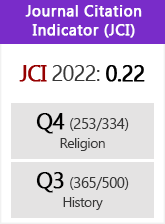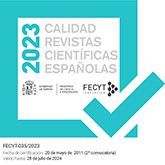A Compendium of Arabic Grammar in a Castilian Lexicographic Work: the “Treasure” of Diego de Urrea in the Tesoro de la lengua castellana o española of Sebastián de Covarrubias (1611)
DOI:
https://doi.org/10.3989/alqantara.2020.012Keywords:
Covarrubias, Spanish Lexicography, Arabic Grammar, Diego de Urrea, First Arabic StudiesAbstract
El Tesoro de la lengua castellana o española of Covarrubias covers up another treasure: a basic grammar of Arabic spread over the two hundred Arabic etymologies provided by the prominent Arabist, contemporary of the lexicographer, Diego de Urrea.Such is the subject of our study that will be devoted, thanks to linguistic analysis, to highlight in this corpus the explicit and implicit presence of numerous grammatical data that refer to fundamental rules of Arabic grammar such as the derivation system and the morphonology of the verb. The presentation of this data in the Tesoro is made by an original terminology that can only be understood in the context of Arabic grammar and which is a true innovation in the field of Arab grammars composed by contemporary European Arabists. On the other hand, Urrea’s etymologies support the new “verbal root theory” introduced by Erpenius in his Grammatica Arabica (1613), and therefore suggest his involvement in contemporary arabism. This study shed new light on the place of the Arabic language in the Tesoro of Covarrubias, a place that had remained, since the first modern reissue of the Tesoro in 1943, completely unnoticed by the research. It invites to see in the Tesoro an innovative work in the context of the new scientific interests that, from the end of the 16th century, would be directed towards the emergence of a new science: Orientalism.
Downloads
References
Bohas, Georges, Contribution à l'étude de la méthode des grammairiens arabes en morphologie et en phonologie, Université de Lille, Atelier national de reproduction des thèses, 1982.
Bohas, Georges, "Sur l'hypothèse de la racine triconsonantique en syriaque", Langues et Littératures du Monde Arabe, 5 (2004), pp. 135-158.
Bohas, Georges y Guillaume, Jean-Patrick, Étude des grammairiens arabes I. Morphologie et Phonologie, Institut français de Damas, 1984.
Carter, Michael G., Arab Linguistics. An introductory classical text with translation and notes, Amsterdam, John Benjamins B.V, 1981. https://doi.org/10.1075/sihols.24
Corominas, Joan y Pascual, José Antonio, Diccionario crítico etimológico castellano e hispánico (DCECH), Madrid, Gredos, 1980.
Corriente, Federico, Árabe andalusí y lenguas romances, Madrid, Editorial Mapfre, 1992.
Corriente, Federico, Diccionario de arabismos y voces afines en iberorromance, Madrid, Gredos, 1999.
Corriente, Federico: A gramatical sketch of the Spanish Arabic dialect bundle, Madrid, Instituto hispano-árabe de cultura, 1977.
Covarrubias Orozco, Sebastián de, Tesoro de la lengua castellana o española [1611], Martín de Riquer (ed.) (1943), reimpr., Barcelona, Editorial Alta Fulla, 2003.
Covarrubias Orozco, Sebastián de, Tesoro de la lengua castellana o española, Ignacio Arellano y Rafael Zafra (eds.), Madrid, Iberoamericana Vervuert, 2006.
Dozy, Reinhardt, Supplément aux dictionnaires arabes [1881], 3ra ed., E.J. Brill, Leiden, G. P. Maisonneuve et Larose, París, 1967.
Dozy, Reinhardt y Engelmann, W. H., Glossaire des mots espagnols et portugais dérivés de l'arabe, Leiden, E. J. Brill, 1869.
Guadix, Fray Diego de, Diccionario de arabismos: recopilación de algunos nombres arábigos/Diego de Guadix, María Águeda Moreno Moreno (ed.), Universidad de Jaén, 2007.
Guillaume, Jean-Patrick, "Les discussions des grammairiens arabes à propos des marques d'iʽrab", Histoire, Épistémologie, Langage, 20, 2 (1998), pp. 43-62. https://doi.org/10.3406/hel.1998.2711
Kouloughli, Djamel E., "Sur le statut linguistique du 'tanwīn': Contribution à l'étude du système déterminatif de l'arabe", Arabica, t. 48, 1 (2001), pp. 20-50. https://doi.org/10.1163/157005801774229903
Larcher, Pierre, "Où il est montré qu'en arabe classique la racine n'a pas de sens et qu'il n'y a pas de sens à dériver d'elle", Arabica, 42, 3 (1995), pp. 291-314. https://doi.org/10.1163/1570058952583138
Larcher, Pierre, "Parlers arabes nomades et sédentaires et diglossie chez Ibn Ğinnī (IVe/Xe siècle). Sociolinguistique et histoire de la langue vs discours épilinguistique", Al-Qantara, 39, 2 (2018), pp. 359-389. https://doi.org/10.3989/alqantara.2018.012
Larcher, Pierre, Le système verbal de l'arabe classique, Publications de l'Université de Provence, 2003.
Neyrod, Dominique, "'Dize Diego de Urrea que…' o los discursos entrelazados de Diego de Urrea y Sebastián de Covarrubias sobre 'palabras arábigas' en el Tesoro de la lengua castellana o española", en Elena Battaner Moro, Vicente Calvo Fernández, Palma Peña Jiménez (eds.), Historiografía lingüística: líneas actuales de investigación vol. II (2012), Nodus Publikationen, Münster, pp. 655-663.
Neyrod, Dominique, Monument/Document. Études de sémantique grammaticale et lexicale, de métalexicographie et d'historiographie linguistique, (2018), [en línea] disponible en: < https://hal-univ-lemans.archives-ouvertes.fr/tel-02501637 >.
Neyrod, Dominique, "Presencia de la terminología gramatical árabe en el Tesoro de la lengua castellana o española de Covarrubias", María Luisa Calero et al. (eds.), Métodos y resultados actuales en Historiografía de la Lingüística, vol. II (2014), Nodus Publikationen, Münster, pp. 545-553.
Peña, Salvador, "Iʽrāb as Syntax", Zeitschrift für Arabische Linguistik 33 (1997), Harrassowitz Verlag, Wiesbaden, pp. 100-104.
Rodríguez Mediano, Fernando, "Diego de Urrea en Italia", Al-Qantara, 25, 1 (2004), pp. 183-201. https://doi.org/10.3989/alqantara.2004.v25.i1.152
Rodríguez Mediano, Fernando, "Fragmentos de Orientalismo español del siglo XVII", Hispania. Revista Española de Historia, 56, 222 (2006), pp. 243-276. https://doi.org/10.3989/hispania.2006.v66.i222.8
Rodríguez Mediano, Fernando y García-Arenal, Mercedes, "Diego de Urrea y algún traductor más: en torno a las versiones de los "Plomos", Al-Qantara, 23, 2 (2002), pp. 499-516. https://doi.org/10.3989/alqantara.2002.v23.i2.193
Rousseau, Jean, "La racine arabe et son traitement par les grammairiens européens (1505-1831)", Bulletin de la Société de Linguistique de Paris, 79, 1 (1984), pp. 285-321.
Ruhstaller, Stefan, "Un aspecto poco investigado del Tesoro de la lengua castellana o española. La contribución de Covarrubias al estudio de los nombres de lugar", Zeitschrift für Romanische Philologie (ZrP), 131, 2 (2015), pp. 326-354. https://doi.org/10.1515/zrp-2015-0022
Sartori, Manuel, "Ibn al-Ḥāğib et la flexion désinencielle: croyant pas pratiquant", Annales islamologiques, 47 (2013), pp. 499-517.
Solá-Solé, Josep María, "El artículo 'al' en los arabismos del iberrorománico", Romance Philology XXI (1968), pp. 275-285.
Troupeau, Gérard, "Les arabisants européens et le système grammatical arabe", Histoire, Épistémologie, Langage, 2, 1 (1980), pp. 3-7. https://doi.org/10.3406/hel.1980.1048
Troupeau, Gérard, "La notion de 'racine' chez les grammairiens arabes anciens", en Sylvain Auroux et al. (ed.) Matériaux pour une histoire des théories linguistiques, Université de Lille III, Travaux et recherches (1984), pp. 239-245.
Downloads
Published
How to Cite
Issue
Section
License
Copyright (c) 2021 Consejo Superior de Investigaciones Científicas (CSIC)

This work is licensed under a Creative Commons Attribution 4.0 International License.
© CSIC. Manuscripts published in both the printed and online versions of this Journal are the property of Consejo Superior de Investigaciones Científicas, and quoting this source is a requirement for any partial or full reproduction.All contents of this electronic edition, except where otherwise noted, are distributed under a “Creative Commons Attribution 4.0 International” (CC BY 4.0) License. You may read here the basic information and the legal text of the license. The indication of the CC BY 4.0 License must be expressly stated in this way when necessary.
Self-archiving in repositories, personal webpages or similar, of any version other than the published by the Editor, is not allowed.














